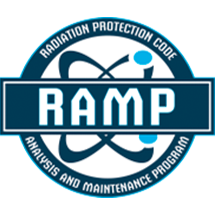I have tried to use RASCAL for materials licenses a few times in the past with little success. The first was during an exercise with a licensee. During that exercise we tried to run dose assessments, however we could not get results similar to the licensee's numbers. The second time was when reviewing a licensee's evaluation for why an EPlan would not be required, and we were not able to use RASCAL because of the site boundary. The challenges with RASCAL for materials licensee's: 1. The minimum release height in RASCAL does not allow for any ground releases, which was the scenario during the exercise. 2. The minimum distance that RASCAL can calculate to (accurately) is significantly different than the site boundary, which could be as close to the release as a few feet.

Issues w/RASCAL for Materials Licenses
This forum post referred to the 10m release height and the 10m calculation distance limitations within RASCAL. While RASCAL can be used to support material accident scenarios, its primary focus is to support protective action decision-making for larger nuclear power plant incidents. The settings of a minimum release height and a minimum calculation distance are designed to keep the RASCAL models from exceeding their limitations and to assure that RASCAL provides reasonable estimates of dispersion. •The 10-meter minimum release height in RASCAL was set because it’s a reasonable “mean” height, considering the size of the reactor and wake effects (e.g. re-circulating plume mixing the material in the downwind cavity of the reactor building). The results start to become insensitive to release height at sufficiently far downwind distances (miles), where RASCAL is intended to be used. Allowing lower release heights would add great uncertainty to the results close to the release points. •Similarly, there are many complicating factors that overwhelm dispersion at close-in calculation distances. Dispersion models, such as RASCAL, were never designed to provide reasonable estimates at these distances. Most of the model theory (developed from field studies) in Gaussian models (like RASCAL) was developed at 100’s of meters downwind from the release. And though the models can mathematically produce an answer at shorter distances, the theory has not been validated in the very “near-field” region. In general, materials accidents are dealing with far less activity being released to the atmosphere than possible severe accidents from nuclear power plants. Other models, such as ARCON96 and Department of Energy's HotSpot, may provide additional modeling capabilities for close-in releases and shorter release heights. •ARCON96 has been developed in NRC licensing space and provides "design" concentrations that might be seen near reactors for control room habitability analysis. The theory in ARCON96 attempts to better address the near-field effects; however, it differs from RASCAL in that it addresses worst-case design concentrations that might be seen in a control room. This results in a higher level of modeling confidence but uses multiple realizations to do so, making it difficult to model a single realization for a given incident. •Hotspot provides a fast and usually conservative means for estimation of the radiation effects associated with atmospheric release of radioactive materials. The HotSpot atmospheric dispersion models are designed for near-surface releases, short-range (less than 10 km) dispersion, and short-term (less than 24 hours) release durations in unobstructed terrain and simple meteorological conditions. While Hotspot is able to address closer distances and shorter release heights by including initial plume dimensions (initial sigma y and sigma z), it is generally expected that it would be difficult for a user to obtain this information during an incident. As the intended purpose of each of these codes is different, and therefore the modeling assumptions within are different, it is expected that resulting outputs may be orders of magnitude different for largely similar release conditions. You will need to find the appropriate model for your situation.